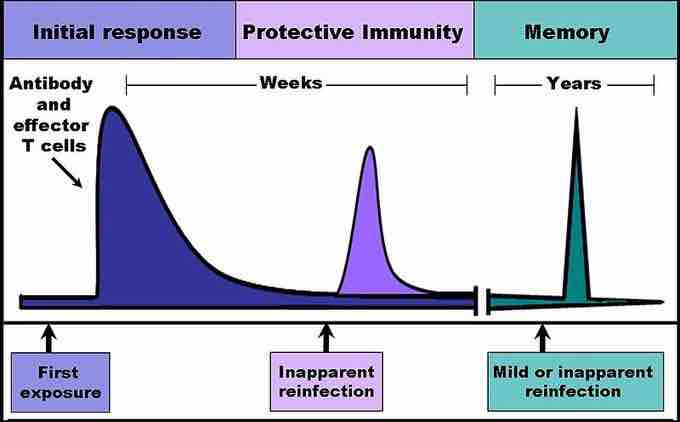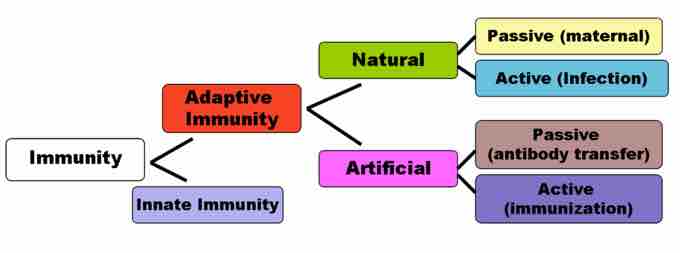The immune system is a system of biological structures and processes within an organism that protects against disease. To function properly, an immune system must detect a wide variety of agents, from viruses to parasitic worms, and distinguish them from the organism's own healthy tissue.
Pathogens can rapidly evolve and adapt to avoid detection and neutralization by the immune system. As a result, multiple defense mechanisms have also evolved to recognize and neutralize pathogens. Even simple unicellular organisms, such as bacteria, possess a rudimentary immune system in the form of enzymes that protect against bacteriophage infections. Other basic immune mechanisms including include phagocytosis, antimicrobial peptides called defensins, and the complement system, which evolved in ancient eukaryotes and remain in modern descendants, such as plants and insects. Jawed vertebrates have even more sophisticated defense mechanisms, including the ability to adapt over time to recognize specific pathogens more efficiently. Adaptive (acquired) immunity creates immunological memory after an initial response to a specific pathogen, leading to an enhanced response to subsequent encounters with that same pathogen. This process of acquired immunity is the basis of vaccination.
Innate and Adaptive Immunity
The immune system protects organisms from infection with layered defenses of increasing specificity. Physical barriers prevent pathogens, such as bacteria and viruses, from entering the organism. If a pathogen breaches these barriers, the innate immune system provides an immediate, but non-specific response. Innate immune systems are found in all plants and animals. If pathogens successfully evade the innate response, vertebrates possess a second layer of protection, the adaptive immune system, which is activated by the innate response. The immune system adapts its response during an infection in order to improve its recognition of the pathogen. This improved response is then retained after the pathogen has been eliminated, in the form of an immunological memory, and allows the adaptive immune system to mount faster and stronger attacks when this pathogen is encountered . Both innate and adaptive immunity depend on the ability of the immune system to distinguish between self and non-self molecules, where self molecules are those components of an organism's body that can be distinguished from foreign substances by the immune system.

The Time Course of an Immune Response
Immune reactants, such as antibodies and effector T-cells, work to eliminate an infection, and their levels and activity rapidly increase following an encounter with an infectious agent, whether that agent is a pathogen or a vaccine. For several weeks these reactants remain in the serum and lymphatic tissues and provide protective immunity against reinfection by the same agent. During an early reinfection, few outward symptoms of illness are present, but the levels of immune reactants increase and are detectable in the blood and/or lymph. Following clearance of the infection, antibody level and effector T cell activity gradually declines. Because immunological memory has developed, reinfection at later times leads to a rapid increase in antibody production and effector T cell activity. These later infections can be mild or even inapparent.
Immunity is a biological term that describes a state of having sufficient biological defences to avoid infection, disease, or other unwanted biological invasion. Immunity involves both specific and non-specific components .

Immunity
Natural immunity occurs through contact with a disease causing agent, when the contact was not deliberate, where as artificial immunity develops only through deliberate actions of exposure. Both natural and artificial immunity can be further subdivided, depending on the amount of time the protection lasts. Passive immunity is short lived, and usually lasts only a few months, whereas protection via active immunity lasts much longer, and is sometimes life-long.
INNATE IMMUNITY
Innate, or nonspecific, immunity is the natural resistance with which a person is born. It provides resistance through several physical, chemical, and cellular approaches. Microbes first encounter the epithelial layers (physical barriers that line our skin and mucous membranes). Subsequent general defenses include secreted chemical signals (cytokines), antimicrobial substances, fever, and phagocytic activity associated with the inflammatory response. The phagocytes express cell surface receptors that can bind and respond to common molecular patterns expressed on the surface of invading microbes. Through these approaches, innate immunity can prevent the colonization, entry, and spread of microbes.

An animal's immune response to a foreign body
Macrophages begin to fuse with, and inject its toxins into, the cancer cell. The cell starts rounding up and loses its spikes. As the macrophage cell becomes smooth. The cancer cell appears lumpy in the last stage before it dies. These lumps are actually the macrophages fused within the cancer cell. The cancer cell then loses its morphology, shrinks up and dies. Photo magnification: 3: x8,000 Type: B & W print
ADAPTIVE IMMUNITY
Adaptive immunity is often sub-divided into two major types depending on how the immunity was introduced. Naturally acquired immunity occurs through contact with a disease causing agent, when the contact was not deliberate, whereas artificially acquired immunity develops only through deliberate actions such as vaccination. Both naturally and artificially acquired immunity can be further subdivided depending on whether immunity is induced in the host or passively transferred from an immune host. Passive immunity is acquired through transfer of antibodies or activated T cells from an immune host, and is short lived—usually lasting only a few months. Active immunity is induced in the host itself by antigen, and lasts much longer, sometimes the entire lifetime.
A further subdivision of adaptive immunity is characterized by the cells involved; humoral immunity is the aspect of immunity that is mediated by secreted antibodies, whereas the protection provided by cell-mediated immunity involves T lymphocytes alone. Humoral immunity is active when the organism generates its own antibodies, and passive when antibodies are transferred between individuals. Similarly, cell-mediated immunity is active when the organism's own T cells are stimulated and passive when T cells come from another organism.